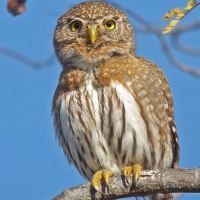Kingdom Animalia Class Aves Family Strigidae Scientific name Glaucidium hoskinsii | Phylum Chordata Order Strigiformes Genus Glaucidium Rank Species | |
 | ||
Similar Yungas pygmy owl, Albertine owlet, Colima pygmy owl, Tamaulipas pygmy owl, Sjöstedt's barred owlet | ||
The cape pygmy owl or Baja pygmy owl (Glaucidium gnoma hoskinsii) is a subspecies of northern pygmy owl restricted to the Mexican state of Baja California Sur. Although some taxonomists consider it to be a distinct species, many authorities do not consider it separate.
Contents
Description
It is 15 to 16.5 cm or 17 cm (6 to 7 inches) long and weighs 50 to 65 grams (1.8–2.3 oz). Its plumage is sandy gray-brown, with females typically more reddish than males. Unlike many related owls, it does not seem to have gray and red morphs. The adult's crown and back have many pale spots, which are biggest on the scapular feathers (where the wings join the back). The tail is long for an owl and is crossed by five or six pale bars. The underparts are off-white with brown streaks. The face shows little contrast except for white "false eyebrows". Like other pygmy owls (Glaucidium), it has yellow irises and a yellow bill, as well as two white-outlined black triangles on the back on the neck that suggest eyespots.
The commonly heard call is distinctly different from that of other pygmy owls in the region: a hoo hoo lasting about two seconds, with five to fifteen seconds between double hoots. This species occasionally begins a bout of hooting with up to five hoots in series. It may also utter "a rapid, slightly quavering huhuhu…" that may lead to hooting.
Range and habitat
The cape pygmy owl is endemic to Baja California Sur from the Sierra de la Laguna in the Cape District, where it is fairly common, to the Sierra de la Gigante at least as far north as 26.5°. It inhabits pine and pine-oak woods from 1500 to 2100 meters (5000–7000 ft.) in altitude. In winter it can descend to 500 meters (1,640 ft.).
Classification
The American Ornithologists' Union considers it a subspecies of the northern pygmy owl, Glaucidium gnoma (as it does several other populations). It has also been considered a subspecies of the least pygmy owl. However, it is considered a separate species here following the Handbook of the Birds of the World. According to one authority, DNA evidence suggests that the two species are not closely related.
Etymology
The epithet hoskinsii commemorates Francis Hoskins, an assistant to Marston Abbott Frazar, an ornithologist who the American businessman George Burritt Sennett paid to collect birds in the 1880s. The first specimen of the cape pygmy owl was collected on one of Frazar's expeditions.
